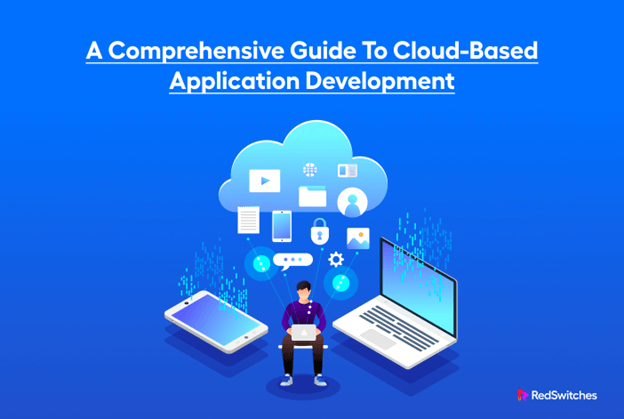Most businesses in all major industries have transitioned to a cloud-first model. So, it’s easy to see why application development in cloud computing has become synonymous with modern software development.
Cloud applications can be directly accessed by anyone, and many businesses have used them, even without knowledge. However, for many people developing applications in cloud computing is still a mystery.
Modern companies utilize the cloud for data backup, disaster recovery, software creation and testing, big data analytics, and client web apps. Financial services firms use the cloud for real-time fraud protection, while online developers use it to provide apps to millions.
In this article, we’ll go into the details of cloud-based application development, the process of using the environment for writing great apps, and the benefits businesses get from application development using cloud computing.
Table of Content
- What is a Cloud-Based Application?
- Characteristics of a Cloud-Based Application
- What are the Benefits of a Cloud App?
- How to Develop a Cloud-Based App?
- What is the Cost of Creating a Cloud-Based App?
- Cloud Application Example
- How RedSwitches Optimizes Cloud-based Application Development
- Conclusion
- FAQs
What is a Cloud-Based Application?
A cloud-based app is a software that operates and stores data in the cloud. Every application can store and access data multiple times while serving a user request. For this, developers rent dedicated bare-metal servers from hosting vendors.
Users can interact with cloud-based apps through a browser running on any device with an internet connection. The user interacts with the application that accepts input and processes it to generate and deliver the expected output.
Characteristics of a Cloud-Based Application
The key characteristics of a cloud-based application include the following:
- The app stores data and operates in the cloud, partially caching data on users’ devices to enhance user experience. This reduces minimum system requirements and allows users to use a broader range of devices to access the application.
- Developers can easily integrate third-party APIs. As a result, cloud-based apps are more customizable than other types of applications.
- Any device connected to the internet (including desktops, tablets, and mobiles) can access a cloud app remotely.
- Modern cloud apps temporarily store data on a user’s device for easy offline access. The cloud app will resume uploading data to the cloud when the user goes online.
- Users can customize backup schedules, data compression, encrypting, and optimization to enhance performance.
What are the Benefits of a Cloud App?
The following are the advantages of utilizing application development in cloud computing for creating cloud apps.
Improved App Performance
Users get faster and more reliable services when businesses deliver services through cloud-based apps. In addition, app development in a cloud environment improves data access and customer experience, offering personalized data insights.
Increased Uptime
Cloud applications are built to offer redundant services. This means they can remain online even when disaster strikes. Service providers usually back up app data at multiple locations, ensuring that it’s available at all times.
The pay-as-you-go business model ensures you get higher returns on investment as you only pay for what you need.
Scalability
Cloud infrastructure hosting the application allows the scalability of resources. This means that regardless of the load on the application, it continues to deliver services to visitors. This happens because the underlying resources can keep pace with the increasing traffic without significant additional expenses.
Easy Updates
Applications hosted in the cloud instantly refresh and update. This removes the need for manual updates that take time and complicate application maintenance. It also speeds up time to market and lets businesses integrate advanced technologies, such as AI and ML, into their applications.
Better Security
Cloud computing architecture is built for security. As a result, the applications hosted on these platforms have multi-level watertight security. Reliable cloud hosting providers often hire top security specialists and deploy the latest security measure for continued application security.
How to Develop a Cloud-Based App?
Developing applications in cloud computing can be complex because of multiple factors. Before you start your app development process, consider factors like project size, operational requirements, client expectations, the number and expertise of the development team, and the project deadline.
Let’s go into the nuts and bolts of the process to understand these factors better.
What is the Process of Application Development?
Application development is creating apps that adhere to the established industry guidelines. The process involves conceptualizing, designing, developing, testing, and releasing apps to the users.
All software development agencies, regardless of size, have a well-defined application development in the cloud computing process that details the responsibilities of all team members.
The Major Steps in Application Development
Developing cloud computing applications is a meticulous process that has the following steps :
Planning and Research
To ensure your app’s success, you must devote considerable time to planning and addressing numerous high-level issues concerning the marketability of your product.
This may involve doing market research and feasibility studies. First, consider your application’s mission, why it’s needed, and its value proposition.
Before investing in application development using cloud computing, find out if your idea has a strong market. Consider the competition and audience size while choosing a platform for your app.
Prototyping
Prototyping is creating wireframes and iterating on customer feedback. A wireframe is a low-fidelity guideline to your app’s user interface (UI) and user experience (UX), giving you a rough idea of its operation and flow.
InVision and other tools can help you gather app wireframe feedback. It’s crucial to receive lots of feedback from your target audience because it’s essential to building an app that users can use (and pay for). Your wireframes must depict the most important features and transitions so that the designers and developers know the process implementation.
Design
Designing an app involves multi-layered steps. UX and UI designers must revise wireframes, create UI elements, design user flow, and comprehend element hierarchy.
Detailed mockups that mention what happens when items are tapped, swiped, and dragged help developers turn ideas into functional apps.
Develop
At this stage, developers write the app’s “final” code that translates the mockups into a functional app.
The essential features are developed first to prepare the core application for the following stages.
Testing
Testing should be done alongside the development. Continuous testing reduces post-release costs and allows you to catch issues before becoming the final product. Testing an app usually involves multiple tests that highlight serious flaws. While this might increase the production cycle, testing can reduce maintenance and support costs.
Testing also pays off in-app maintenance. For instance, after an update, you may run all the test cases to find out what areas need improvement without manually testing each case.
Release
Once the app has been thoroughly tested, it is usually deployed to a production server where users can access it. Releasing an app is not the end of the road. It can kick off the entire cycle again as users stress-test the application. You’ll find the app’s limits and failures.
After releasing the app, you’re back to prototyping. Again, review user feedback, make the changes to the design and functionality, and re-release.
Maintenance
This stage begins with release and should progress concurrently. Maintaining your app involves checking for faults, fixing them, and ensuring it works as planned. It also consists in updating the server software to accommodate new app features.
As a general rule, application maintenance is an ongoing process. You continuously check user feedback, use analytics tools to measure and monitor usage, and add to the application development backlog.
What is the Cost of Creating a Cloud-Based App?
A typical cloud-based mobile app costs $40,000–$150,000 and takes 300–600 hours to build. Time and cost vary greatly depending on the application’s complexity and value proposition.
A moderately sophisticated cloud application can take 600-800 hours to develop. It may approach 1200 hours, depending on project needs. A similar application may cost $40,000–$65,000.
Cloud Application Example
In one way or another, the Cloud is already embedded in many apps we rely on daily. Application development in cloud computing has produced fantastic tools and services like:
Miro is a digital board where you can collaborate with others in exciting and creative ways. Figma is a robust, cloud-based design program gaining much traction in the industry due to its teamwork-friendly interface.
Dropbox and Google Drive make it simple to upload files to the cloud and share them with anybody from any device.
How RedSwitches Optimizes Cloud-based Application Development
Developing, deploying, and maintaining applications requires a high-performing infrastructure that supports all process phases.
Whatever type of application you’re building, you’ll find bare-metal servers simply superb for building and delivering your applications to the users. RedSwitches allows you to maintain a cloud infrastructure that fully supports your team at all stages of development.
Since we understand what your team needs for creating and maintaining cloud applications, our bare-metal servers can be customized to accommodate your specific workflows. And, if you run into a hosting-related issue, you have access to 24/7 customer support whenever you need to make minor or significant changes to your servers.
Conclusion
- Modern businesses require cloud-based applications to run their day-to-day activities. However, many don’t understand how to develop cloud computing applications.
- Cloud-based collaborative application development has become an industry standard for most companies. It’s similar to popular software development methodologies.
- Utilizing application development in cloud computing has many benefits, such as improved app performance, increased uptime, better security, and easy updates.
- However, the heart of high-performing app development processes is powerful hosting. That’s because cloud apps require high-performing infrastructure supporting all development phases.
- RedSwitches’ Dedicated and bare-metal servers ensure the team has all the resources required for application development cloud computing.
Need a bare-metal server to deploy your app? RedSwitches can provide you with the speed and connectivity needed. Let us know your preferences and what resources you use to ensure the final release’s quality.
FAQS
Here are some frequently asked questions concerning cloud-based applications:
Q-1) What is the Difference Between Web Applications and Cloud Applications?
Web-based apps run in a browser. They are made by combining user calligraphy like Java and Adobe Flash with a script from a server. Online web services depend on the device’s web server.
Cloud-based apps are more advanced. They develop and mature as web apps before becoming cloud-based apps. Like multi-tenant apps, cloud-based apps use internet browsers but don’t need them to run.
Q-2) Is it AWS Cloud or DevOps?
AWS is a cloud that is the world’s most popular and widely used cloud computing service. AWS offers a variety of services that are designed specifically for use with AWS and that can assist your business in implementing DevOps.
These solutions automate tedious activities, let teams scale complex settings, and keep engineers in charge of DevOps’ high pace.



